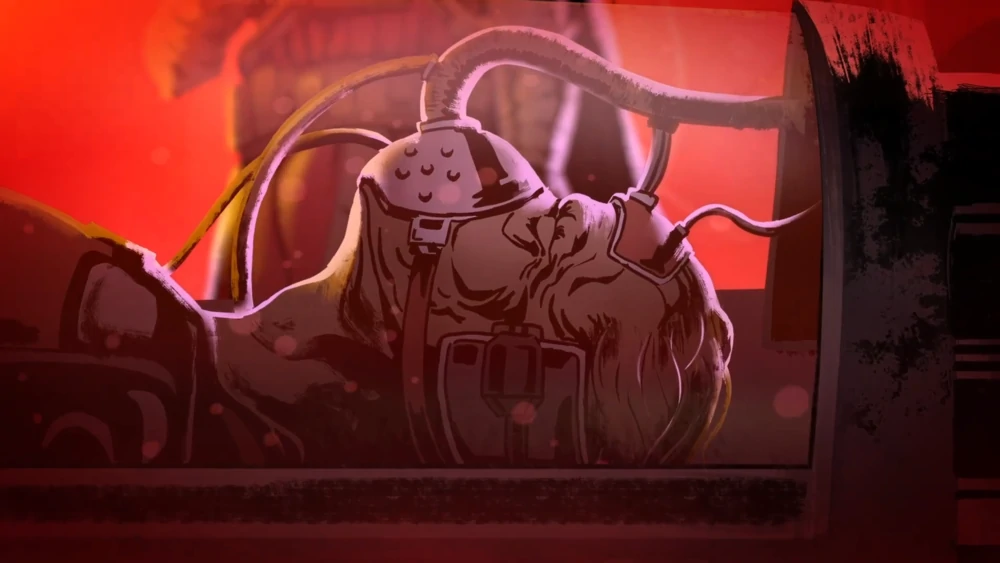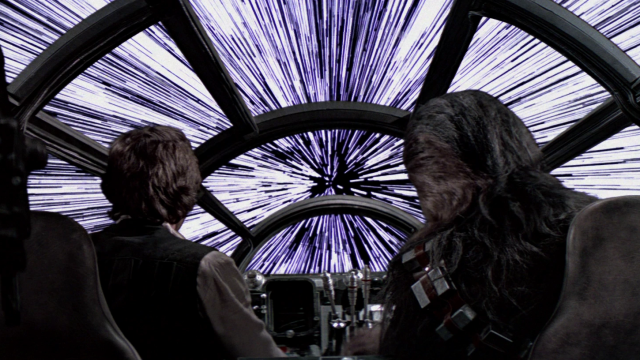Lucasfilm’s version of faster-than-light travel — hyperspace — is as fundamental to the worldbuilding of Star Wars as the Force. It’s the backbone of making its galaxy an interconnected universe of potential, a concept that has become more and more integral to some of the franchise’s biggest storytelling pushes. But how it works, and how people use it, has become more complex and fascinating than ever.
So What Is Hyperspace?
Hyperspace is one of the oldest elements of Star Wars we know, having first glimpsed it in action when the Millennium Falcon raced on its way from Tatooine towards Alderaan (or, what was left of it) in 1977’s A New Hope. Although the concept of faster-than-light travel is no stranger to science fiction, how Star Wars has started playing with it in recent years has made it one of its most quietly compelling worldbuilding mechanics. It can be charted, travelled, manipulated, even weaponised — and the very ramifications of using it outside of the expected point-a-to-point-b mechanics can upend what we thought we knew about the galaxy far, far away in an instant.
On its most simple level, hyperspace — not unlike Star Trek’s warp speed or myriad other sci-fi series’ take on interstellar travel — is an alternate dimension of reality that vessels (among other things) can slip in and out of at speeds unbound by the rules of physics in realspace. Accessible only by breaking the speed of light (jumping to lightspeed, as it’s known in Star Wars lingo), time and velocity operate differently in hyperspace, vastly reducing the time it takes to get from one point to another. Its discovery formed the possibility for galactic civilisation as we know it in Star Wars to actually exist.

It’s not all that easy though. Navigating it is still not fundamentally unlike travelling in realspace, it just happens at impossible-to-comprehend speeds. Things that exist in realspace cast adjacent shadows in hyperspace, meaning navigation can be difficult without proper knowledge or, as we will see become common in the Star Wars galaxy, pre-charted safe routes. Travelling in hyperspace can be incredibly dangerous both during the process and coming out of it.
As Han tells Luke in A New Hope, an unplanned exit (intentional or otherwise) could lead you to come out of hyperspace in the middle of a star, or within the gravity well of a planet or spatial anomaly. Hitting another ship or debris in hyperspace can have massive ramifications — in hyperspace and realspace — even beyond the fatal consequence of hitting something else at FTL speeds.
We’ve witnessed this in the Great Distaster of the High Republic era, when debris from a ship destroyed mid-hyperspace travel was shot across the known galaxy and accelerated to speeds capable of wiping out entire planets. Hyperspace might be fundamental to how the Star Wars galaxy works, but it’s also something that, even by the time of the movies, people generally just don’t know all that much about.
How Do You Travel Through Hyperspace?
Most hyperspace travel we see in Star Wars media is technological; starships, everything from as small as an X-Wing to as large as a Star Destroyer, as long as it had a hyperdrive, could enter and exit the dimension. Fuelled by hypermatter, the engines shoot vessels to the speed that allows them to break into hyperspace in the first place, maintaining their mass and velocity (which is how Admiral Holdo’s manoeuvre in The Last Jedi proved to be so devastating).
This travel takes place along hyperspace lanes, safe passageways in the dimension that had been charted out hundreds and hundreds of years beforehand by the earliest explorers of the Old Republic, marked by beacons which provide route data and computational power as well as physical guide points to ships as they made jumps. In “contemporary” Star Wars — for want of a better word about a story that takes place a “long time ago” — the computation power and layouts of those routes required to travel was now handled by onboard navigational systems known as navicomputers, or, to enhance limited computers in smaller vessels, an astromech droid’s internal systems.

Vessels could also fall out of hyperspace, intentionally or otherwise, at other points. Failure of a hyperdrive, for example, would cause a ship to jerk back into realspace. But they could also be forced: a gravitational pull could affect the velocity needed to breach hyperspace (which is why attempting to jump to lightspeed within the atmosphere of a planet was considered dangerous enough to be close to impossible) and a strong enough pull could block or terminate the process.
The Empire built specific cruisers, known as the Interdictor class, that generated powerful gravity wells that could both stop nearby ships from entering hyperspace and pull them out mid-jump. This technology was vital to the Empire as, for much of Star Wars’ history, it was deemed impossible to track a vessel once it made the jump to lightspeed. Just decades later, however, Imperial successor the First Order cracked the ability to do so. It broke a generation of conventional wisdom by isolating a computer system in a localised hyperspace field and accelerating its programming capabilities.
Are There Other Ways to Travel in Hyperspace?
Yes, there are other ways to navigate hyperspace. The Chiss Ascendancy existed in the “Unknown Regions” of the galaxy which had not been charted by hyperspace prospectors for the Galactic Republic or the Empire. They employed a secretive corps of hyperspace navigators (known in their language as ozyly-esehembo) to help facilitate the computations required to navigate the volatile spaces in the region. Translated into basic as “Sky-walkers,” these Chiss were primarily very young girls between the ages of eight and 13. Sensitive to the Force, they had what was known in Chiss culture as “Third Sight,” the precognitive ability to help ships navigate through realspace and to map limited hyperspace jumps.
Kept secret from all except the upper echelons of Chiss military and public society, each ship in the Ascendancy navy would be assigned a Sky-walker, and they would rotate out frequently. Why? Because Sky-walkers, no matter what training or preventative measures were taken, largely lost their ability to use Third Sight by the time they were teenagers.

The Chiss were not the only Force-sensitive species that could use those abilities in such a manner, however incredibly rare such a manifestation of power actually was. In the time of the High Republic — roughly 200 years before the events of the main Star Wars movies — a force-sensitive human named Mari San Tekka could use her abilities to detect safe, but unconventional passageways through hyperspace known simply as “Paths.” Deemed too risky or even impossible by traditional prospectors’ standards, San Tekka’s paths could defy previously held conventional wisdom — like the ability to enter and exit hyperspace near spatial anomalies, or within and near the gravitational pull of a planet.
Due to the rarity of her abilities, however, San Tekka was an extremely valuable asset. She was captured and utilised exclusively by the pirate force known as the Nihil and sustained well beyond her natural lifespan by being hooked into medical systems aboard the flagship of the Nihil’s leader Marchion Ro (and his father before him, Asgar), the Gaze Electric. As they accelerated their operation outside of the Outer Rim territories they originated in and became a galactic-scale threat to the Republic, every ship was equipped with a “Path Engine.” It was a secondary hyperdrive that translated the data provided by San Tekka’s abilities into more standardised navigational information.
But humanoids weren’t the only sapient beings that could tap into this biological method of navigation. Introduced in Star Wars Rebels, the Purrgil were a species of whale-like semi-sentients that lived in deep space and had the unique natural ability to manifest “simu-tunnels” in hyperspace. While rare in and of themselves, Purrgils have taken on an almost folkloric status among space pilots and navigators.
They’re ancient enough that it’s believed the study of their travel is what inspired galactic society to develop their own means of travelling through hyperspace in the first place, thousands of years before the Star Wars films. Additionally, their biological ways of travel and thought-processing formed the basis for the technology behind everything from the Wayfinders of ancient Force orders like the Jedi and Sith, to the hyperspace beacons and drives that made early intergalactic scouting possible.
